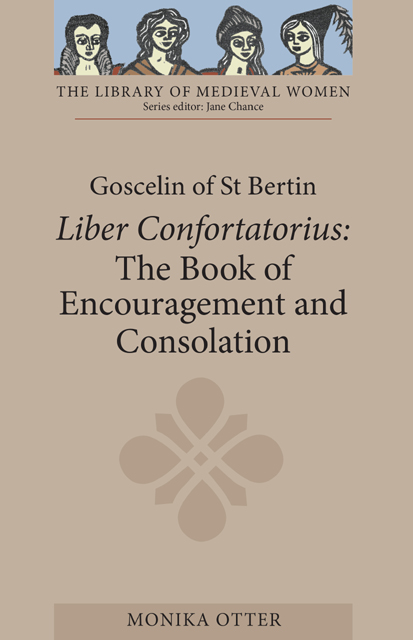Introduction
Published online by Cambridge University Press: 21 March 2023
Summary
The Liber Confortatorius [the Book of Encouragement and Consolation] is an idiosyncratic and extraordinarily rich document from the late eleventh century. A letter of guidance to a female recluse by her male spiritual adviser, a guide to meditation and prayer, and an anthology of spiritual and meditative texts, it is also a personal letter and an account of a deep, desperate, only half sublimated love between a man and a woman in religious orders. Taking up the tradition of St. Jerome’s letters of spiritual guidance to holy women, it anticipates better-known medieval advice literature for anchoresses, especially Aelred’s De Institutione Inclusarum and the Ancrene Wisse. Many of Goscelin’s concerns and rhetorical strategies will sound familiar to readers of these later works. But the Liber Confortatorius is sui generis, criss-crossing and deconstructing all the dividing lines that are so important to the Ancrene Wisse and similar texts: inside-outside, teacher-pupil, male-female, parent-child.
Anchorites, Anchoritic Literature, and the Liber Confortatorius
The late eleventh and twelfth centuries were a time of religious experimentation, a time when many people attempted to fashion new and often independent ways to act out their personal religiosity, the right “rule” to live by. The great monastic movements of the previous centuries had concentrated on reforming coenobitic (communal) monasticism, to return it to stricter observance and to its pristine, austere origins. These efforts continued, and generated new movements and new religious orders. At the same time, many people were attracted to eremitic lifestyles, inspired in part by the immensely popular literature of the early Christian “Desert Fathers” of the Near East. Even those who remained in communal life or were very much involved in active politics and administration often drew heavily on the rhetoric and imagery of “the desert,” of seclusion and asceticism. Some put these ideals into practice. They might withdraw to a “desert” or wilderness in imitation of the early Christian desert fathers, or they might live as anchorites or anchoresses in cells attached to churches or monasteries, often in the middle of town yet solitary and unseen. The latter form in particular attracted many women, indeed more women than men. Some anchorites and hermits were true solitaries, others had companions or servants, or (like Eva, the addressee of the Liber Confortatorius) lived in small colonies of recluses who might share some devotions or practical arrangements and offer each other some rudimentary support.
- Type
- Chapter
- Information
- Goscelin of St BertinThe Book of Encouragement and Consolation [Liber Confortatorius], pp. 1 - 16Publisher: Boydell & BrewerPrint publication year: 2004



